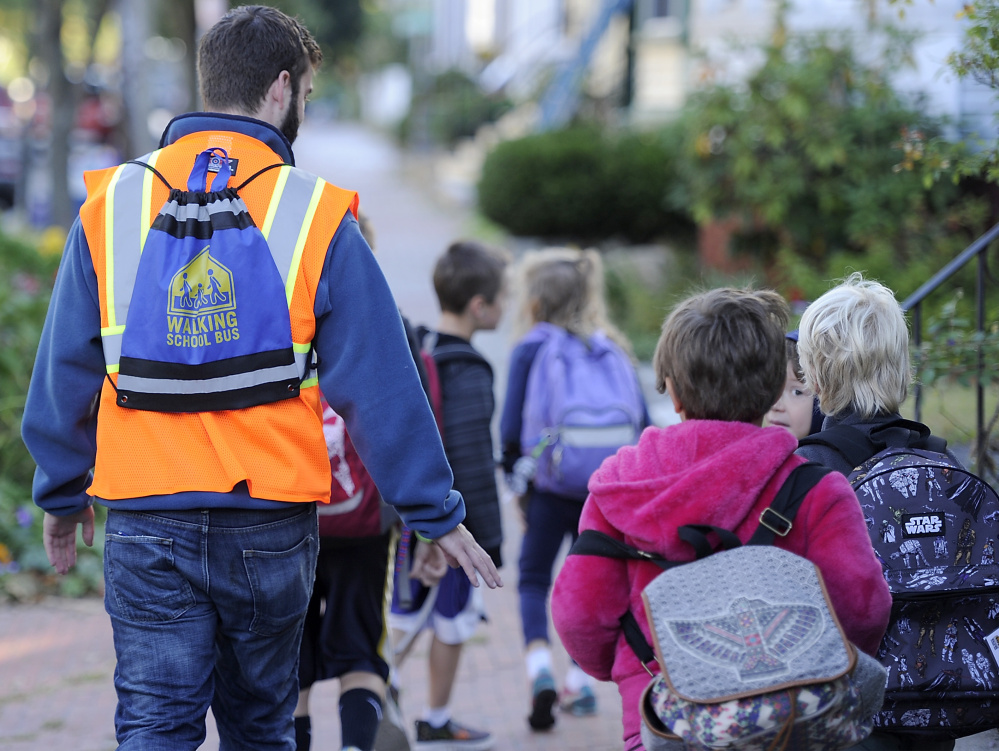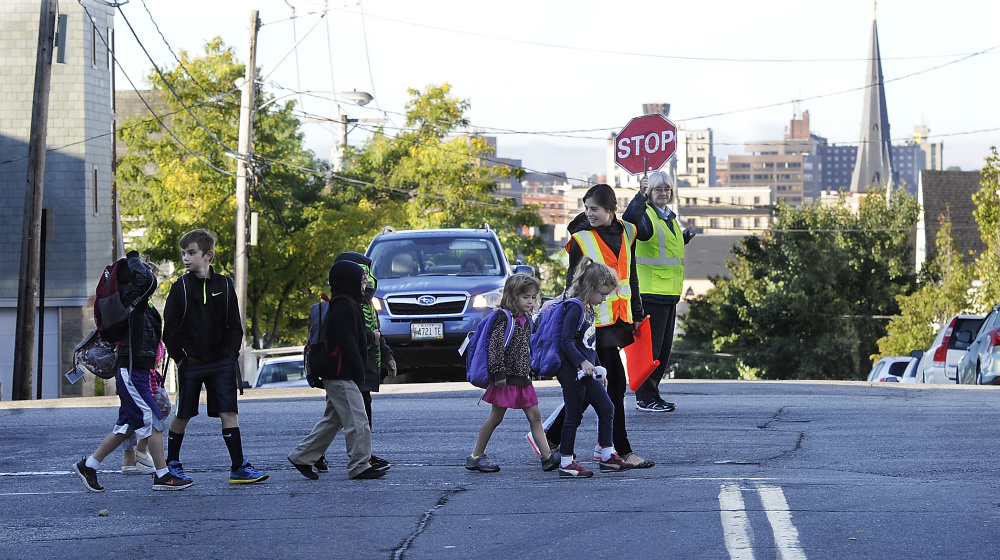Have you seen Portland’s coolest school bus snaking through the Munjoy Hill neighborhood? There’s no yellow vehicle, just a straggly line of elementary schoolchildren led by two adult volunteers in safety vests.
I joined the Walking School Bus, as it is called, on a glorious September morning. We began at the Eastern Promenade and made our way to East End Community School, passing million-dollar mansions and modest apartments housing recent immigrants.
Every block or two, we picked up more children. Boys hauling Star Wars backpacks and girls in sparkly sandals gave their parents goodbye kisses before joining us. As we approached the school, 18 children of many nationalities laughed, told jokes and greeted neighborhood dogs.
“We run rain or shine or snow,” says Sarah Cushman, a planner for the Maine Walking School Bus program. In 2½ years, the program has canceled only once, because of extreme cold.
Some students choose to walk even though they qualify for school bus transportation. The program offers other families a safe alternative to having their children get to school on their own.
Victoire Liwanga Bukaka Matadi signed up two of her children last year when they immigrated to Portland from the Democratic Republic of Congo. She says the Walking School Bus is very helpful because the family doesn’t have a car. Mitadi appreciates the kindness of the volunteers who care for her children on the walk.
The East End Community School is one of three schools statewide offering daily Walking School Buses. The others are in Ellsworth and Norway. At each location, two or more trained adult volunteers walk along an established route of about a mile every morning, picking up children just as a bus would.
The fresh air and exercise helps students arrive at school ready to learn. Ronan Mas, a third-grader at the East End Community School, rarely misses a day.
“It calms you down before your school day,” Ronan says. “It’s a nice time to talk to friends.”
The program connects people in the community who might not otherwise meet. Many volunteers are retirees or young adults without children. “The volunteers love that they go to the park on Sunday and run into kids they know,” said Cushman. “Kids totally love that, too.”
The East End walking bus program has helped forge relationships between new Mainers and longtime Munjoy Hill residents. Immigrant parents appreciate the way that volunteers show up dependably, make sure the children have warm clothes in winter and teach them American norms such as being on time, Cushman said.
Nationally, the number of children walking and biking to school plummeted from 48 percent to 13 percent between 1969 and 2009, according to the National Center for Safe Routes to School.
Surveys conducted by the Maine Safe Routes to School program show that many parents consider roads too dangerous for walking, or they worry about strangers hurting their youngsters. Parents also say that the distance to school is too long, the winter weather makes it too difficult and that it’s more convenient to drop off their children on the way to work.
In 2014, the Maine Center for Disease Control and Prevention provided funding to launch the state Walking School Bus program. The Bicycle Coalition of Maine and the Maine Department of Transportation are partners.
Participating schools receive $5,000 annual stipends for a volunteer coordinator, plus technical support, training and recruitment materials. After two years of funding, schools are expected to take over the program.
One of the biggest challenges is finding volunteers who will commit to walking once a week. Those who sign up say they love the experience.
Elise Moody-Roberts, 26, began volunteering with the East End Community School Walking School Bus last fall. She’s led the group on recycling days, when students marvel at the interesting garbage along the route. She speaks Portuguese, so she is able to converse with Angolan students and parents.
“After every morning,” Moody-Roberts says, “I just have some nice memories that will keep me smiling.”
Throughout the country, more than 200 school districts in 29 states have begun Walking School Buses in the past decade with the help of PedNet, a nonprofit specializing in walking and bicycling. (PedNet helped in the planning of Maine’s program.) Some districts have been able to reduce bus transportation as a result of the Walking School Buses.
Portland City Councilor Kevin Donoghue signed up his daughter, a kindergartner at East End Community School, for the Walking School Bus. He is intrigued with the possibility of a larger program here.
“As a parent, I’m thrilled that there are volunteers to make sure that my daughter has this safe and active experience,” Donoghue said. “As a city councilor, it makes me wonder about the relative cost and utility of this model versus traditional busing.”
Moody-Roberts recently became the school’s Walking School Bus coordinator. She hopes to expand the program by adding one or two more routes, but she needs more volunteers in order to do so.
Maine’s other two Walking School Buses also need more volunteers. If you live in Portland, Norway or Ellsworth, please consider signing up for one hour a week. Find out more at walkingschoolbus.me.
The Maine program will add up to three new schools this year. Encourage your local elementary school to apply. The deadline is in November.
Shoshana Hoose is a freelance writer who bicycles in Greater Portland and beyond. Contact her at shoshanahoose@gmail.com.
Send questions/comments to the editors.




Comments are no longer available on this story